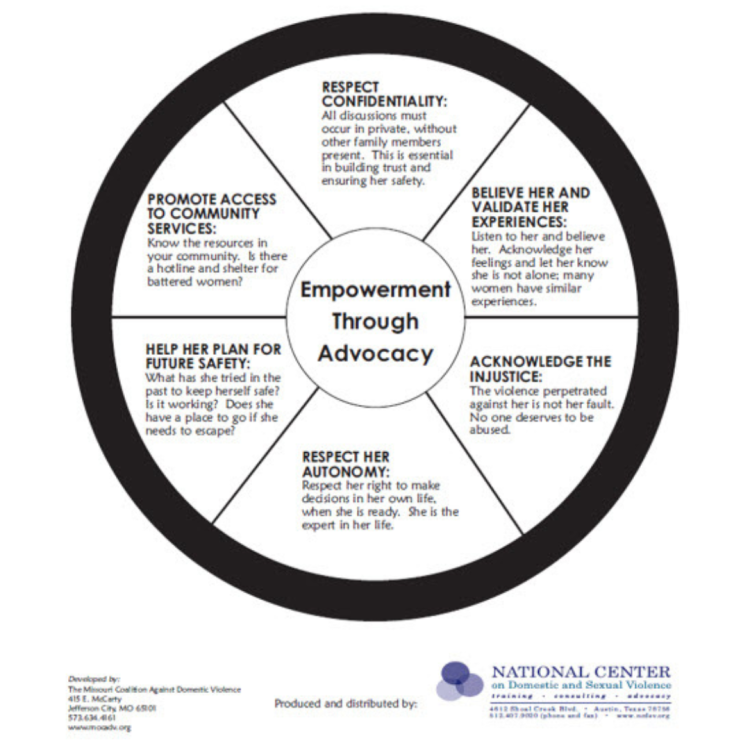Help A Friend
Domestic Abuse is surprisingly complex and dangerous. You may think you are helping a person who has experienced abuse, when your actions are actually putting them and their children at greater risk of harm. Learn what to do and what not to do by consulting the Advocacy Wheel below.
In Our Country:
- 1 in 3 women (35.6%) and 1 in 4 men (28.5%) have experienced rape, physical violence and/or stalking by an intimate partner. This issue is affecting more than 12 million people each year.
- Each year, around 8 million paid work days (equating to 32,000 full-time jobs) are lost because of domestic violence-related issues.
In Our Christian Families:
- Researchers in family violence have argued that abuse crosses all religious boundaries. Concluding, the rates inside and outside the church walls are similar.
- 54% of religious victims and 38% of non-religious victims sought help from a religious professional after violence in the home.
Against Our Children:
- 30 – 60% of men who batter women also batter their children. Therefore, the presence of spouse abuse is the single most identifiable risk factor for predicting child abuse. (National Domestic Violence Hotline)
- Studies have shown that children who witness violence in the home are 15 times more likely to experience physical or sexual abuse in their lifetime.
To learn specific actions that constitute abuse, please refer to the Power And Control wheel below.
This issue of Domestic Abuse is not about anger, it is about one person’s desire for power and control in a relationship.
According to the National Domestic Violence Hotline, domestic violence is defined as a pattern of behavior used by one partner to maintain power and control over another partner in an intimate relationship.
Abuse may include physical, sexual, emotional, economic, or psychological actions, or threats of actions that influence another person.
This includes any behaviors that frighten, intimidate, terrorize, manipulate, hurt, humiliate, blame, injure or wound someone.
Additionally, abuse knows no boundaries and occurs within relationships regardless of education, economic status, ethnicity or religious background.
To learn specific actions that constitute abuse, please refer to the Power and Control Wheel below.
It can be overwhelming and confusing to support someone who has disclosed that they are being abused. Below are some suggestions on how you can effectively help them.
- Respect confidentiality. It is a privilege to be trusted with this disclosure.
- Believe them! Fear of not being believed results in unreported abuse.
- Acknowledge the injustice. There is never an excuse for abusive behavior.
- Respect autonomy. Encourage and empower your friend, rather than trying to rescue her/him.
- Encourage them to contact a local domestic violence organization for safety planning and access to community resources.
- Maintain healthy boundaries
What is not helpful?
- Minimizing the situation.
- Judgmental or shaming comments. Quoting scripture on submission.
- Making decisions or taking actions on behalf of the survivor.
- Confronting their partner or attempting to “solve their problem” without expertise.
- Questioning or try to influence their decision to stay or leave.
To learn specific actions that constitute abuse, please refer to the Power and Control Wheel below.
Anyone is capable of domestic violence, regardless of age, gender, marital status, education level, career, faith background, income.
A domestic violence abuser can look like…
From the outside it is often impossible to spot an abusive individual. Abusive individuals may appear to be a well respected member of the community or a family oriented, doting partner. They may thrive on being the center of attention and enjoy positions of leadership and authority. Abusers may be male or female. While the large majority of cases of abuse include women as victims and men as perpetrators, men are also subject to abuse and women are capable of perpetrating domestic violence.
Below is a non-exhaustive list of traits and characteristics of an individual who may be experiencing abuse.
- Seems to be on edge all the time
- Constantly checks in with the person who is abusing them
- Seems unable to make decisions without consulting their abuser, even with seemingly mundane things
- Frequently questions their sanity when asking for your advice
- Appears depressed, withdrawn and lacking self-confidence
- Loses interest in hobbies and activities
- Always has good reasons for withdrawing
- Seems to micromanage others in the household to cater to the preferences/needs of abuser
- Avoids talking about themselves; redirects conversations so their personal life is not the topic of discussion

Learn About Our Services
Get Involved
Be Inspired, Learn, Take a Stand
Hagar's Sisters
P.O. Box 2260
Acton, MA 01720


